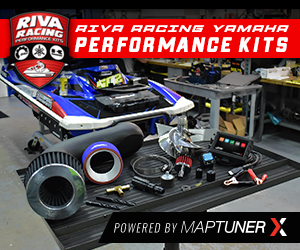Undoubtedly, many of you reading this are returning back to your daily occupations trying to shake off the lengthy holiday weekend. Whether or not you’ve set any personal resolutions to complete this calendar year, the closing of 2015 and the ushering in of 2016 is one to reflect, contemplate and review. But we’re saving up “2015 in Review” for another date. Rather, we’re setting our sights forward and looking down the barrel of what the new year will unveil to us lovers of all things personal watercraft.
Normally, we’d reserve this spot specifically for casting predictions for the year but we’ve got so much chatter coming over the telegraph wires that we’d be remiss to not include a few projections for future product coming to a shoreline and showroom near you before the end of the calendar year. Admittedly, much is hearsay and whisperings – but such is all forms of early intelligence. What we look for are patterns. How many reliable sources are predicting the same things? That’s where you get solid intel.
We’re going to share quite a bit of new product here that has been in waiting for years. What makes 2016 different from previous years? The economy. When things got really tight, you saw manufacturers tighten up on unrolling new hull designs, innovations, and added technology as sales were at a near standstill. With new unit sales growth up into the double digits, and a record number of floor sales in the past 6 years, the OEs are seeing enthusiasts champing for new and exciting product. So for now, we’ll handle this alphabetically:
Kawasaki
The thinly-differentiated Ultra 310 lineup still reigns supreme in every single offshore and endurance event (and will continue to do so in 2016), but is beginning to fade in public view. We’ve argued privately that Kawasaki is sitting on the single-richest vein of brand name equity in the industry. Kawasaki “started it all,” and many who started their love affair with PWC did so on a JS440 or JS550 standup, and while they might be currently riding a RXP-X or FZR, many would jump at the chance to buy a Kawasaki again if they made a unit suitable to their riding wants/needs.
Currently, Kawasaki is clinging on to its single-digit percentage of marketshare. To reclaim a little more ground, the Big K is visibly lacking three things: first, a mid-sized/two-seater musclecraft – similar to the aforementioned Sea-Doo RXP-X 300 and the Yamaha FZR SVHO. This is not to take away from the Ultra 310X, as it is unflinchingly powerful, but many riders want something far more nimble and scaled back in size. We’ve belabored the notion of reintroducing the STX-R as a 310-horsepower closed course-killer, so we’ll just let you click the link.
Second, a true entry-level craft. We’ve already previously confirmed that Kawasaki is preparing a “new runabout for people just getting into the sport.” This, in our eyes, is a Rec-Lite segment craft – similar to the incredibly popular Sea-Doo Spark, whether in spirit or build design. And make note: this is happening. You heard it here first, folks. And lastly is its dealer network, which has dwindled in recent years. It’s easy to believe that will correct itself in implementing the above two suggestions.
Sea-Doo
People are impatient by nature, and its certain that many of you are already seeing message boards and social media feeds full of enthusiasts taking early delivery of their new 300-horsepower Sea-Doos. There are even a handful of tuners already unlocking the restrictive ECUs pushing their brand new ACE 300-powered machines into the high 70s and even surpassing 80mph. Horsepower is always sexy and Sea-Doo’s jump from 260 to 300 will definitely garner BRP some very happy customers, if not lure lookie-loos into showrooms.
Although corporate race support isn’t that of Yamaha’s, it’s all but assured that starting lines will be rife with new Sea-Doo RXP-X and RXT-X units – be it in closed course or in the newly enlarged US AquaX series. What the new ACE 300 and the integration of the ErgoLock system allows is for more sportsman-level riders to try their hand at racing, and we’re betting that we’ll welcome a new crop of hardcore enthusiasts to the sport in large portion because of it. And if that’s the legacy that Sea-Doo leaves for 2016, we think it’ll be just plenty.
On the flip side, we do predict the dissemination of the new ACE 300 engine – in a non-supercharged format – throughout the rest of the current Sea-Doo lineup for 2017. Rotax engineers dedicated quite a bit of time, effort and resources in improving the outgoing 1503 Rotax 4-tec three-cylinder, and it’s clearly evident in the new ACE 300. Even without the service-free supercharger, the innovations put into the new ACE stands to provide power and efficiency gains for all levels of Sea-Doo PWC – from the GTI 130 to the GTX 155.
Yamaha
OK, this is where we go waaay out on a limb. Over the past six months we’ve been hearing a whole heck of a lot of chatter about Yamaha’s brass and their growing interest in expanding the SuperJet’s presence. As it stands, SuperJet sales are the highest in nearly a decade and Yamaha continues to increase its production numbers to satisfy demand (and keep people in dealerships instead of on Craigslist). The result is an influx of new 2-stroke SuperJets hitting the water…that is, where they’re permitted to ride.
See, 2-strokes are still persona non grata in many States in the US, and unless something seriously reverses in the political realm, it’s unlikely things will change anytime soon. Rather that mothballing the SuperJet because of this (as did Kawasaki), Yamaha is looking at bringing the SuperJet into the 21st century thanks in large part to the new TR-1 plant introduced for 2016. The new 1.1-liter three-cylinder 4-stroke is as much lightweight as it is powerful – producing approximately 120-naturally-aspirated-horsepower.
Commonly, the two biggest concerns of a 4-stroke conversion are weight and water ingestion, and with the TR-1 equal to that of a three-cylinder (“triple”) build – tipping the scales around 150-pounds when fully dressed, the likelihood of a TR-1 powered SuperJet is very high, whether for 2017 or later. Already aftermarket builders have applied the new TR-1 to conventional SuperJet and lightweight aftermarket hulls with great success, and its certain that Yamaha is paying close attention to public demand.












